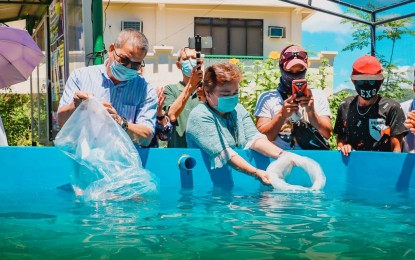
TILAPIA IN TANKS. Bureau of Fisheries and Aquatic Resources (BFAR) Eastern Visayas regional director Juan Albaladejo (left) and Department of Agriculture regional executive director Angel Enriquez (right) release tilapia fingerlings in a tank during a project launch on May 27, 2020 in Tacloban City. BFAR is eyeing 19,747 more metrics tons (MT) yield via several government interventions for fishermen in the region displaced by the health crisis. (Photo courtesy of BFAR Region 8)
TACLOBAN CITY – The Bureau of Fisheries and Aquatic Resources (BFAR) is eyeing an additional 19,747 metrics tons (MT) yield through several government interventions for fishermen in Eastern Visayas displaced by the health crisis.
Some PHP21 million from the BFAR regular budget and United Nations-funded fisheries coastal resources and livelihood (FishCORAL) project have been diverted to finance livelihood interventions in response to impacts of the movement restrictions, said BFAR regional director Juan Albaladejo in a phone interview on Tuesday.
Among the major activities are the establishment of mangrove crab nursery in six provinces and procurement of seven million high-quality milkfish fry shipped from Sarangani province.
Milkfish fry has been distributed to two BFAR technology outreach stations in Jiabong, Samar, and Lavezares, Northern Samar.
The rest was delivered to fishpond operators through the buy-now-pay-later scheme in San Jose and Rosario in Northern Samar; Sta. Margarita in Samar; General Macarthur in Eastern Samar; Leyte, Merida, and Barugo in Leyte province.
“Participating fishpond operators will pay in kind from 10 percent of their production of five to six inches fingerlings size to BFAR for distribution to fish cage operators under the fish cage for livelihood program,” Albaladejo said.
BFAR is also pushing for intensive tilapia culture in ponds as an alternative livelihood through aquaculture. The government is putting fixed cages along Leyte Gulf and floating cages in three Samar provinces for tilapia production in both fresh and brackish water.
BFAR has also started its technology demonstration in tilapia in tanks in all six provinces to be coupled with aquaponics.
Also part of the special fund for health crisis is the assistance to mussel and oyster producers and lobster farmers in the region.
BFAR will turnover assorted 1,500 fishing paraphernalia and over 133 motorized 20 and 30-footer fiber reinforced plastic boats.
Last April, BFAR brought its mobile market to interior villages in the region to make protein-rich food available to non-coastal communities.
The initiative dubbed as “Love Lab-as (fresh)” sells not just aquatic products, but also meat, vegetables, root crops, and other natural food meant to boost ones’ immune system. It is a one flatbed truck to serve as a fish stall and a refrigerated van to keep the fish fresh.
The region, known for its major fishing grounds in six provinces, has recorded an average of 30,000 MT harvest of fishery products every quarter in 2019. (PNA)
